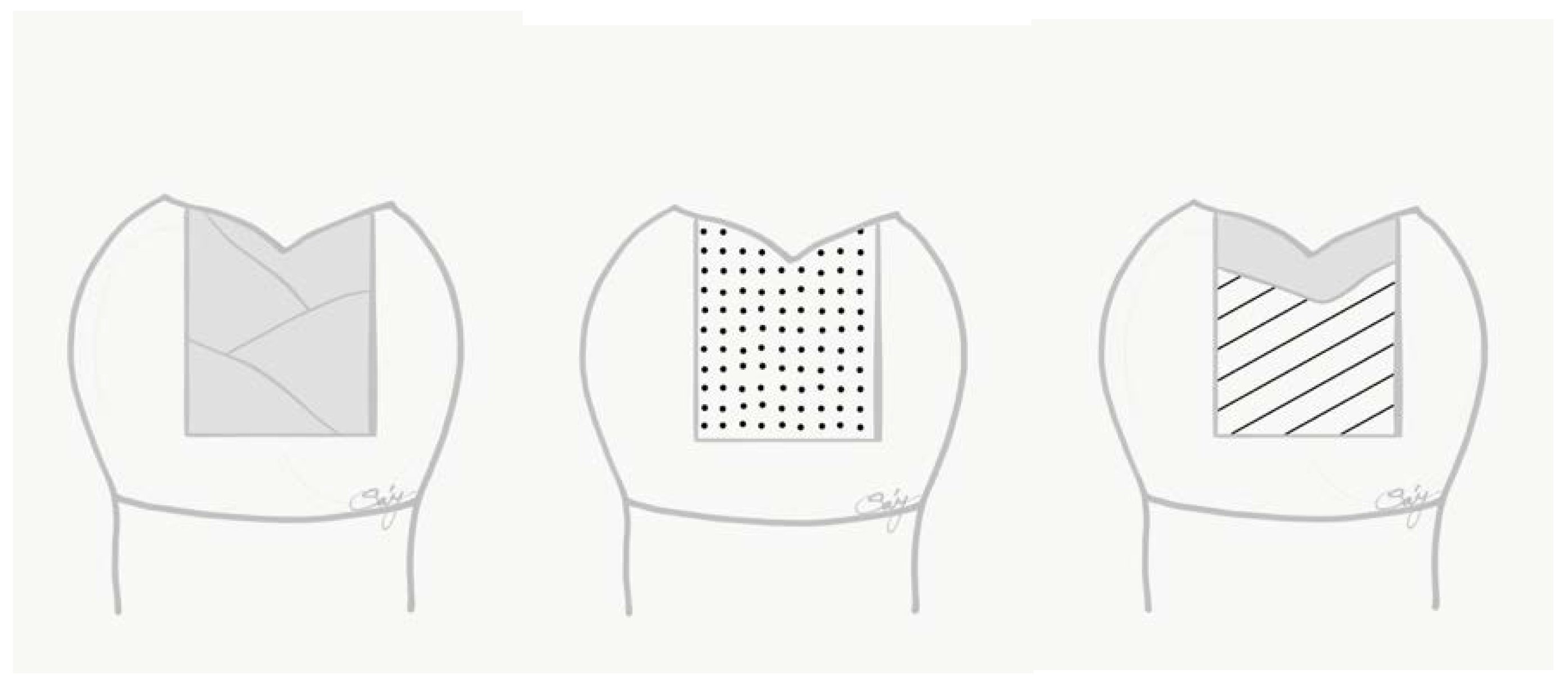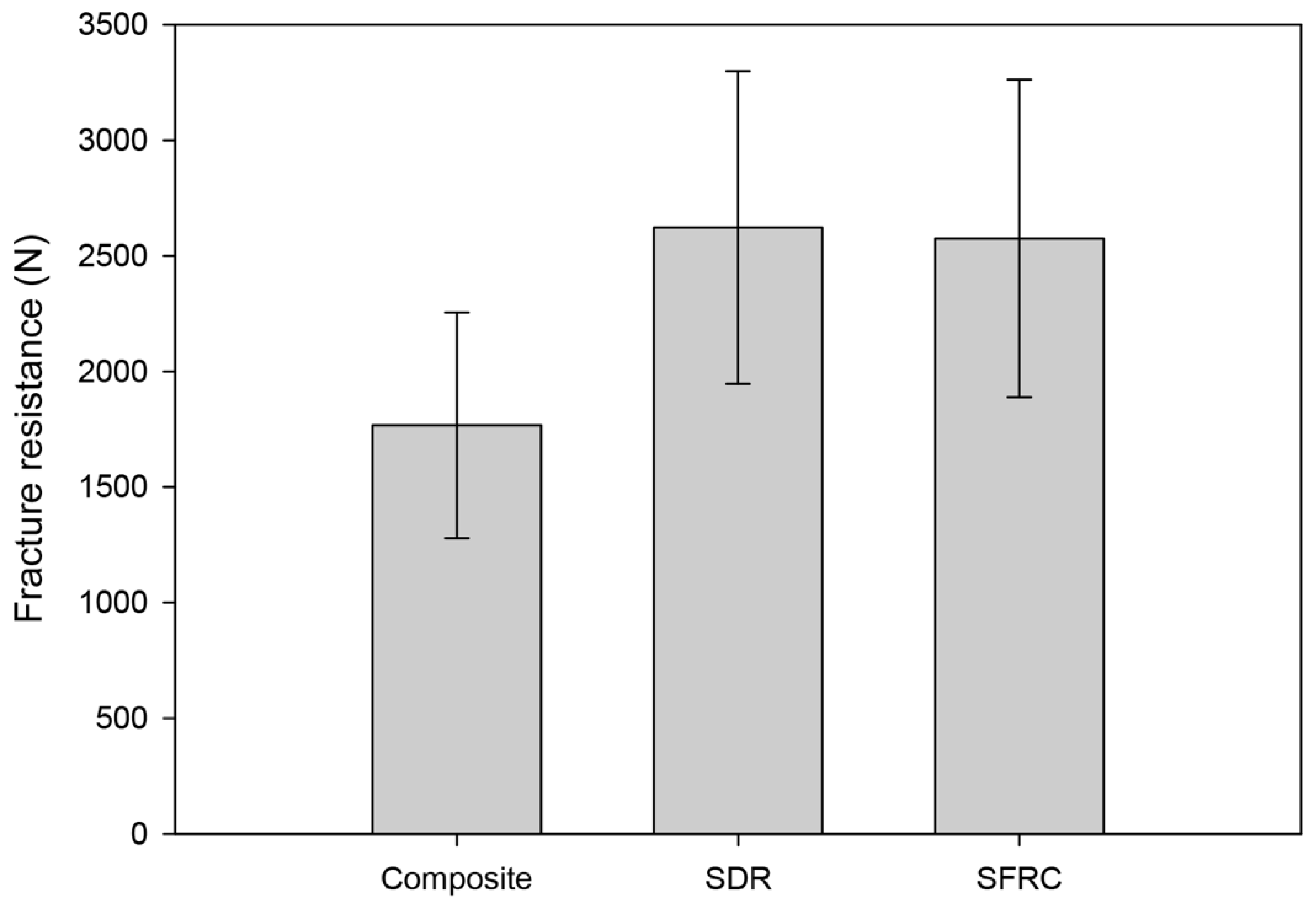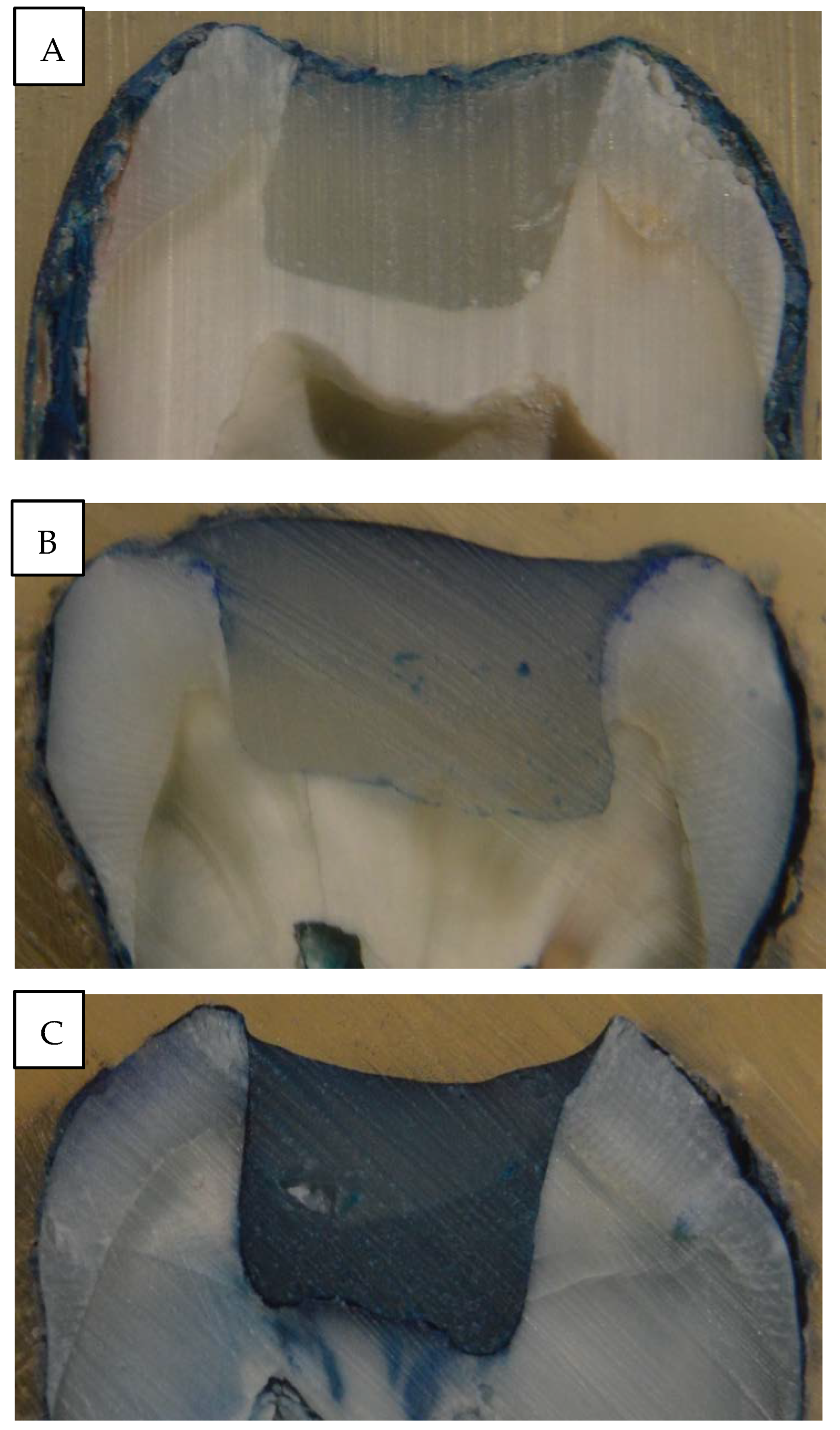Fracture Resistance and Microleakage around Direct Restorations in High C-Factor Cavities
Abstract
:1. Introduction
2. Materials and Methods
2.1. Cavity Preparation
2.2. Restoration
2.3. Mechanical Testing
2.4. Microleakage Testing and Gap Formation Evaluation
3. Results
4. Discussion
5. Conclusions
Author Contributions
Funding
Institutional Review Board Statement
Informed Consent Statement
Data Availability Statement
Conflicts of Interest
References
- Haak, R.; Näke, T.; Park, K.J.; Ziebolz, D.; Krause, F.; Schneider, H. Internal and marginal adaptation of high-viscosity bulk-fill composites in class II cavities placed with different adhesive strategies. Odontology 2019, 107, 374–382. [Google Scholar] [CrossRef] [PubMed]
- Opdam, N.J.; van de Sande, F.H.; Bronkhorst, E.; Cenci, M.S.; Bottenberg, P.; Pallesen, U.; Gaengler, P.; Lindberg, A.; Huysmans, M.C.; van Dijken, J.W. Longevity of posterior composite restorations: A systematic review and meta-analysis. J. Dent. Res. 2014, 93, 943–949. [Google Scholar] [CrossRef]
- Demarco, F.F.; Corrêa, M.B.; Cenci, M.S.; Moraes, R.R.; Opdam, N.J. Longevity of posterior composite restorations: Not only a matter of materials. Dent. Mater. 2012, 28, 87–101. [Google Scholar] [CrossRef] [PubMed]
- Peutzfeldt, A.; Mühlebach, S.; Lussi, A.; Flury, S. Marginal Gap Formation in Approximal “Bulk Fill” Resin Composite Restorations After Artificial Ageing. Oper. Dent. 2018, 43, 180–189. [Google Scholar] [CrossRef] [PubMed]
- Soares, C.J.; Faria-E-Silva, A.L.; Rodrigues, M.P.; Vilela, A.B.F.; Pfeifer, C.S.; Tantbirojn, D.; Versluis, A. Polymerization shrinkage stress of composite resins and resin cements—What do we need to know? Braz. Oral Res. 2017, 31, e62. [Google Scholar] [CrossRef]
- Cardoso, M.V.; de Almeida Neves, A.; Mine, A.; Coutinho, E.; Van Landuyt, K.; De Munck, J.; Van Meerbeek, B. Current aspects on bonding effectiveness and stability in adhesive dentistry. Aust. Dent. J. 2011, 56, 31–44. [Google Scholar] [CrossRef]
- Manauta, J.; Salat, A.; Putignano, A.; Devoto, W.; Paolone, G.; Hardan, L.S. Stratification in anterior teeth using one dentine shade and a predefined thickness of enamel: A new concept in composite layering—Part I. Odontostomatol. Trop. 2014, 37, 5–16. [Google Scholar]
- Manauta, J.; Salat, A.; Putignano, A.; Devoto, W.; Paolone, G.; Hardan, L.S. Stratification in anterior teeth using one dentine shade and a predefined thickness of enamel: A new concept in composite layering—Part II. Odontostomatol. Trop. 2014, 37, 5–13. [Google Scholar]
- Alqudaihi, F.S.; Cook, N.B.; Diefenderfer, K.E.; Bottino, M.C.; Platt, J.A. Comparison of Internal Adaptation of Bulk-fill and Increment-fill Resin Composite Materials. Oper. Dent. 2019, 44, 32–44. [Google Scholar] [CrossRef]
- Fronza, B.M.; Rueggeberg, F.A.; Braga, R.R.; Mogilevych, B.; Soares, L.E.; Martin, A.A.; Ambrosano, G.; Giannini, M. Monomer conversion, microhardness, internal marginal adaptation, and shrinkage stress of bulk-fill resin composites. Dent. Mater. 2015, 31, 1542–1551. [Google Scholar] [CrossRef] [PubMed]
- Park, J.; Chang, J.; Ferracane, J.; Lee, I.B. How should composite be layered to reduce shrinkage stress: Incremental or bulk filling? Dent. Mater. 2008, 24, 1501–1505. [Google Scholar] [CrossRef] [PubMed]
- Flury, S.; Peutzfeldt, A.; Lussi, A. Influence of increment thickness on microhardness and dentin bond strength of bulk fill resin composites. Dent. Mater. 2014, 30, 1104–1112. [Google Scholar] [CrossRef] [PubMed]
- Cerda-Rizo, E.R.; de Paula Rodrigues, M.; Vilela, A.; Braga, S.; Oliveira, L.; Garcia-Silva, T.C.; Soares, C.J. Bonding Interaction and Shrinkage Stress of Low-viscosity Bulk Fill Resin Composites with High-viscosity Bulk Fill or Conventional Resin Composites. Oper. Dent. 2019, 44, 625–636. [Google Scholar] [CrossRef] [PubMed]
- Rosatto, C.M.; Bicalho, A.A.; Veríssimo, C.; Bragança, G.F.; Rodrigues, M.P.; Tantbirojn, D.; Versluis, A.; Soares, C.J. Mechanical properties, shrinkage stress, cuspal strain and fracture resistance of molars restored with bulk-fill composites and incremental filling technique. J. Dent. 2015, 43, 1519–1528. [Google Scholar] [CrossRef] [PubMed]
- Jang, J.H.; Park, S.H.; Hwang, I.N. Polymerization shrinkage and depth of cure of bulk-fill resin composites and highly filled flowable resin. Oper. Dent. 2015, 40, 172–180. [Google Scholar] [CrossRef]
- Park, K.J.; Pfeffer, M.; Näke, T.; Schneider, H.; Ziebolz, D.; Haak, R. Evaluation of low-viscosity bulk-fill composites regarding marginal and internal adaptation. Odontology 2021, 109, 139–148. [Google Scholar] [CrossRef]
- Kim, R.J.; Kim, Y.J.; Choi, N.S.; Lee, I.B. Polymerization shrinkage, modulus, and shrinkage stress related to tooth-restoration interfacial debonding in bulk-fill composites. J. Dent. 2015, 43, 430–439. [Google Scholar] [CrossRef]
- Rizzante, F.A.P.; Mondelli, R.F.L.; Furuse, A.Y.; Borges, A.F.S.; Mendonça, G.; Ishikiriama, S.K. Shrinkage stress and elastic modulus assessment of bulk-fill composites. J. Appl. Oral Sci. 2019, 27, e20180132. [Google Scholar] [CrossRef]
- Deliperi, S.; Alleman, D.; Rudo, D. Stress-reduced Direct Composites for the Restoration of Structurally Compromised Teeth: Fiber Design According to the "Wallpapering" Technique. Oper. Dent. 2017, 42, 233–243. [Google Scholar] [CrossRef]
- Fráter, M.; Sáry, T.; Vincze-Bandi, E.; Volom, A.; Braunitzer, G.; Szabó, P.B.; Garoushi, S.; Forster, A. Fracture Behavior of Short Fiber-Reinforced Direct Restorations in Large MOD Cavities. Polymers 2021, 13, 2040. [Google Scholar] [CrossRef]
- Lassila, L.; Keulemans, F.; Säilynoja, E.; Vallittu, P.K.; Garoushi, S. Mechanical properties and fracture behavior of flowable fiber reinforced composite restorations. Dent. Mater. 2018, 34, 598–606. [Google Scholar] [CrossRef] [PubMed]
- Forster, A.; Braunitzer, G.; Tóth, M.; Szabó, P.B.; Fráter, M. In Vitro Fracture Resistance of Adhesively Restored Molar Teeth with Different MOD Cavity Dimensions. J. Prosthodont. 2019, 28, 325–331. [Google Scholar] [CrossRef] [PubMed] [Green Version]
- Sáry, T.; Garoushi, S.; Braunitzer, G.; Alleman, D.; Volom, A.; Fráter, M. Fracture behaviour of MOD restorations reinforced by various fibre-reinforced techniques—An in vitro study. J. Mech. Behav. Biomed. Mater. 2019, 98, 348–356. [Google Scholar] [CrossRef] [PubMed]
- Molnár, J.; Fráter, M.; Sáry, T.; Braunitzer, G.; Vallittu, P.K.; Lassila, L.; Garoushi, S. Fatigue performance of endodontically treated molars restored with different dentin replacement materials. Dent. Mater. 2022, 38, 83–93. [Google Scholar] [CrossRef] [PubMed]
- Lassila, L.; Säilynoja, E.; Prinssi, R.; Vallittu, P.K.; Garoushi, S. Fracture behavior of Bi-structure fiber-reinforced composite restorations. J. Mech. Behav. Biomed. Mater. 2020, 101, 103444. [Google Scholar] [CrossRef] [PubMed]
- Garoushi, S.; Sungur, S.; Boz, Y.; Ozkan, P.; Vallittu, P.K.; Uctasli, S.; Lassila, L. Influence of short-fiber composite base on fracture behavior of direct and indirect restorations. Clin. Oral Investig. 2021, 25, 4543–4552. [Google Scholar] [CrossRef]
- Zaghloul, M.M.J.; Mohamed, Y.S.; El-Gamal, H. Fatigue and tensile behaviors of fiber-reinforced thermosetting composites embedded with nanoparticles. J. Compos. Mater. 2019, 56, 709–718. [Google Scholar] [CrossRef]
- Zaghloul, M.M.J.; Zaghloul, M.Y.M.; Zaghloul, M.M.Y. Experimental and modeling analysis of mechanical-electrical behaviors of polypropylene composites filled with graphite and MWCNT fillers. Polym. Test. 2017, 63, 467–474. [Google Scholar] [CrossRef]
- Zaghloul, M.Y.M.; Zaghloul, M.M.Y.; Zaghloul, M.M.Y. Developments in polyester composite materials–An in-depth review on natural fibers and nanofillers. Compos. Struct. 2021, 278, 114698. [Google Scholar] [CrossRef]
- Zaghloul, M.M.Y.; Zaghloul, M.M.Y. Influence of flame retardant magnesium hydroxide on the mechanical properties of high density polyethylene composites. J. Reinf. Plast. Compos. 2017, 36, 1802–1816. [Google Scholar] [CrossRef]
- Zaghloul, M.Y.; Zaghloul, M.M.Y.; Zaghloul, M.M.Y. Influence of Stress Level and Fibre Volume Fraction on Fatigue Performance of Glass Fibre-Reinforced Polyester Composites. Polymers 2022, 14, 2662. [Google Scholar] [CrossRef] [PubMed]
- Fuseini, M.; Zaghloul, M.M.Y. Investigation of Electrophoretic Deposition of PANI Nano fibers as a Manufacturing Technology for corrosion protection. Prog. Org. Coat. 2022, 171, 107015. [Google Scholar] [CrossRef]
- Bijelic-Donova, J.; Garoushi, S.; Lassila, L.V.; Keulemans, F.; Vallittu, P.K. Mechanical and structural characterization of discontinuous fiber-reinforced dental resin composite. J. Dent. 2016, 52, 70–78. [Google Scholar] [CrossRef] [PubMed]
- Alshabib, A.; Jurado, C.A.; Tsujimoto, A. Short fiber-reinforced resin-based composites (SFRCs); Current status and future perspectives. Dent. Mater. J. 2022, 20, 2022–2080. [Google Scholar] [CrossRef] [PubMed]
- Garoushi, S.; Gargoum, A.; Vallittu, P.K.; Lassila, L. Short fiber-reinforced composite restorations: A review of the current literature. J. Investig. Clin. Dent. 2018, 9, 12330. [Google Scholar] [CrossRef] [PubMed]
- Lempel, E.; Őri, Z.; Szalma, J.; Lovász, B.V.; Kiss, A.; Tóth, Á.; Kunsági-Máté, S. Effect of exposure time and pre-heating on the conversion degree of conventional, bulk-fill, fiber reinforced and polyacid-modified resin composites. Dent. Mater. 2019, 35, 217–228. [Google Scholar] [CrossRef]
- Lempel, E.; Őri, Z.; Kincses, D.; Lovász, B.V.; Kunsági-Máté, S.; Szalma, J. Degree of conversion and in vitro temperature rise of pulp chamber during polymerization of flowable and sculptable conventional, bulk-fill and short-fibre reinforced resin composites. Dent. Mater. 2021, 37, 983–997. [Google Scholar] [CrossRef] [PubMed]
- Fráter, M.; Forster, A.; Keresztúri, M.; Braunitzer, G.; Nagy, K. In vitro fracture resistance of molar teeth restored with a short fibre-reinforced composite material. J. Dent. 2014, 42, 1143–1450. [Google Scholar] [CrossRef]
- Yamazaki, P.C.; Bedran-Russo, A.K.; Pereira, P.N.; Wsift, E.J., Jr. Microleakage evaluation of a new low-shrinkage composite restorative material. Oper. Dent. 2006, 31, 670–676. [Google Scholar] [CrossRef]
- Da Rosa Rodolpho, P.A.; Donassollo, T.A.; Cenci, M.S.; Loguércio, A.D.; Moraes, R.R.; Bronkhorst, E.M.; Opdam, N.J.; Demarco, F.F. 22-Year clinical evaluation of the performance of two posterior composites with different filler characteristics. Dent. Mater. 2011, 27, 955–963. [Google Scholar] [CrossRef]
- Manhart, J.; Kunzelmann, K.H.; Chen, H.Y.; Hickel, R. Mechanical properties and wear behavior of light-cured packable composite resins. Dent. Mater. 2000, 16, 33–40. [Google Scholar] [CrossRef]
- Behery, H.; El-Mowafy, O.; El-Badrawy, W.; Saleh, B.; Nabih, S. Cuspal Deflection of Premolars Restored with Bulk-Fill Composite Resins. J. Esthet. Restor. Dent. 2016, 28, 122–130. [Google Scholar] [CrossRef] [PubMed]
- Van Ende, A.; De Munck, J.; Mine, A.; Lambrechts, P.; Van Meerbeek, B. Does a low-shrinking composite induce less stress at the adhesive interface? Dent. Mater. 2010, 26, 215–222. [Google Scholar] [CrossRef] [PubMed]
- de Oliveira, I.L.M.; de Brito, O.F.F.; de Melo Monteiro, L.M.C.G.Q.; Resende Montes, M.A.J. Microtensile Bond Strength of Bulk-fill Resin Composite Restorations in High C-factor Cavities. J. Contemp. Dent. Pract. 2020, 21, 626–631. [Google Scholar] [CrossRef]
- Han, S.H.; Sadr, A.; Tagami, J.; Park, S.H. Internal adaptation of resin composites at two configurations: Influence of polymerization shrinkage and stress. Dent. Mater. 2016, 32, 1085–1094. [Google Scholar] [CrossRef]
- Van Ende, A.; De Munck, J.; Van Landuyt, K.L.; Poitevin, A.; Peumans, M.; Van Meerbeek, B. Bulk-filling of high C-factor posterior cavities: Effect on adhesion to cavity-bottom dentin. Dent. Mater. 2013, 29, 269–277. [Google Scholar] [CrossRef] [PubMed]
- Han, S.H.; Park, S.H. Incremental and Bulk-fill Techniques with Bulk-fill Resin Composite in Different Cavity Configurations. Oper. Dent. 2018, 43, 631–641. [Google Scholar] [CrossRef]
- Bonilla, E.D.; Hayashi, M.; Pameijer, C.H.; Le, N.V.; Morrow, B.R.; Garcia-Godoy, F. The effect of two composite placement techniques on fracture resistance of MOD restorations with various resin composites. J. Dent. 2020, 101, 103348. [Google Scholar] [CrossRef]
- Rosa de Lacerda, L.; Bossardi, M.; Silveira Mitterhofer, W.J.; Galbiatti de Carvalho, F.; Carlo, H.L.; Piva, E.; Münchow, E.A. New generation bulk-fill resin composites: Effects on mechanical strength and fracture reliability. J. Mech. Behav. Biomed. Mater. 2019, 96, 214–218. [Google Scholar] [CrossRef]
- de Assis, F.S.; Lima, S.N.; Tonetto, M.R.; Bhandi, S.H.; Pinto, S.C.; Malaquias, P.; Loguercio, A.D.; Bandéca, M.C. Evaluation of Bond Strength, Marginal Integrity, and Fracture Strength of Bulk- vs Incrementally-filled Restorations. J. Adhes. Dent. 2016, 18, 317–323. [Google Scholar] [CrossRef]
- Al-Nahedh, H.N.; Alawami, Z. Fracture Resistance and Marginal Adaptation of Capped and Uncapped Bulk-fill Resin-based Materials. Oper. Dent. 2020, 45, 43–56. [Google Scholar] [CrossRef] [PubMed]
- Garoushi, S.; Mangoush, E.; Vallittu, P.K.; Lassila, L. Short fiber reinforced composite: A new alternative for direct onlay restorations. Open Dent. J. 2013, 7, 181–185. [Google Scholar] [CrossRef] [PubMed] [Green Version]
- Fennis, W.M.; Kreulen, C.M.; Tezvergil, A.; Lassila, L.; Vallittu, P.K.; Creugers, N.H. In vitro repair of fractured fiber-reinforced cusp-replacing composite restorations. Int. J. Dent. 2011, 2011, 165938. [Google Scholar] [CrossRef]
- Fráter, M.; Lassila, L.; Braunitzer, G.; Vallittu, P.K.; Garoushi, S. Fracture resistance and marginal gap formation of post-core restorations: Influence of different fiber-reinforced composites. Clin. Oral Investig. 2020, 24, 265–276. [Google Scholar] [CrossRef] [PubMed]
- Garoushi, S.; Säilynoja, E.; Vallittu, P.K.; Lassila, L. Physical properties and depth of cure of a new short fiber reinforced composite. Dent. Mater. 2013, 29, 835–841. [Google Scholar] [CrossRef]
- Fráter, M.; Sáry, T.; Jókai, B.; Braunitzer, G.; Säilynoja, E.; Vallittu, P.K.; Lassila, L.; Garoushi, S. Fatigue behavior of endodontically treated premolars restored with different fiber-reinforced designs. Dent. Mater. 2021, 37, 391–402. [Google Scholar] [CrossRef] [PubMed]
- Fronza, B.M.; Makishi, P.; Sadr, A.; Shimada, Y.; Sumi, Y.; Tagami, J.; Giannini, M. Evaluation of bulk-fill systems: Microtensile bond strength and non-destructive imaging of marginal adaptation. Braz. Oral Res. 2018, 32, 80. [Google Scholar] [CrossRef]
- Sousa-Lima, R.X.; Silva, L.; Chaves, L.; Geraldeli, S.; Alonso, R.; Borges, B. Extensive Assessment of the Physical, Mechanical, and Adhesion Behavior of a Low-viscosity Bulk Fill Composite and a Traditional Resin Composite in Tooth Cavities. Oper. Dent. 2017, 42, 159–166. [Google Scholar] [CrossRef]
- Tsujimoto, A.; Nagura, Y.; Barkmeier, W.W.; Watanabe, H.; Johnson, W.W.; Takamizawa, T.; Latta, M.A.; Miyazaki, M. Simulated cuspal deflection and flexural properties of high viscosity bulk-fill and conventional resin composites. J. Mech. Behav. Biomed. Mater. 2018, 87, 111–118. [Google Scholar] [CrossRef]
- Burgess, J.; Cakir, D. Comparative properties of low-shrinkage composite resins. Compend. Contin. Educ. Dent. 2010, 31, 10–15. [Google Scholar] [PubMed]
- Ilie, N.; Hickel, R. Investigations on a methacrylate-based flowable composite based on the SDR™ technology. Dent. Mater. 2011, 27, 348–355. [Google Scholar] [CrossRef] [PubMed]
- Orłowski, M.; Tarczydło, B.; Chałas, R. Evaluation of marginal integrity of four bulk-fill dental composite materials: In vitro study. Sci. World J. 2015, 2015, 701262. [Google Scholar] [CrossRef] [PubMed] [Green Version]
- Tarle, Z.; Attin, T.; Marovic, D.; Andermatt, L.; Ristic, M.; Tauböck, T.T. Influence of irradiation time on subsurface degree of conversion and microhardness of high-viscosity bulk-fill resin composites. Clin. Oral Investig. 2015, 19, 831–840. [Google Scholar] [CrossRef] [PubMed]
- Tauböck, T.T.; Jäger, F.; Attin, T. Polymerization shrinkage and shrinkage force kinetics of high- and low-viscosity dimethacrylate- and ormocer-based bulk-fill resin composites. Odontology 2019, 107, 103–110. [Google Scholar] [CrossRef] [PubMed]
- Braga, R.R.; Hilton, T.J.; Ferracane, J.L. Contraction stress of flowable composite materials and their efficacy as stress-relieving layers. J. Am. Dent. Assoc. 2003, 134, 721–728. [Google Scholar] [CrossRef] [PubMed]
- Thongbai-On, N.; Chotvorrarak, K.; Banomyong, D.; Burrow, M.F.; Osiri, S.; Pattaravisitsate, N. Fracture resistance, gap and void formation in root-filled mandibular molars restored with bulk-fill resin composites and glass-ionomer cement base. J. Investig. Clin. Dent. 2019, 10, 12435. [Google Scholar] [CrossRef]
- Fráter, M.; Sáry, T.; Néma, V.; Braunitzer, G.; Vallittu, P.; Lassila, L.; Garoushi, S. Fatigue failure load of immature anterior teeth: Influence of different fiber post-core systems. Odontology 2021, 109, 222–230. [Google Scholar] [CrossRef]
- Gerula-Szymańska, A.; Kaczor, K.; Lewusz-Butkiewicz, K.; Nowicka, A. Marginal integrity of flowable and packable bulk fill materials used for class II restorations -A systematic review and meta-analysis of in vitro studies. Dent. Mater. J. 2020, 39, 335–344. [Google Scholar] [CrossRef]
- Dietschi, D.; Curto, F.D.; Di Bella, E.; Krejci, I.; Ardu, S. In vitro evaluation of marginal adaptation in medium- and large size direct class II restorations using a bulk-fill or layering technique. J. Dent. 2021, 115, 103828. [Google Scholar] [CrossRef]
- Szabó, V.T.; Szabó, B.; Tarjányi, T.; Trenyik, S.Z.E.; Szabó, P.B.; Fráter, M. Analog and digital modelling of sound and impaired periodontal supporting tissues during mechanical testing. Analecta Tech. Szeged. 2021, 15, 2. [Google Scholar] [CrossRef]





| Category | LOT Number | Material | Manufacturer | Composition |
|---|---|---|---|---|
| Conditioner | BFDJ8 | Ultra-Etch | Ultradent | 35% phosphoric acid, water, cobalt aluminate blue, spinel, glycol, siloxan |
| Adhesive | 1703031 | G-Premio Bond | GC | 10-MDP (5–10%), 4-MET, dimethacrylate (10–20%), dimethacrylate component (1–5%), photo-initiator (1–5%), butylated hydroxytoluene (<1%), acetone (25–50%), water (24%) |
| Composite | N841976 | Filtek Ultimate Composite Resin | 3M | Bis-GMA, UDMA, TEGDMA, Bis-EMA, 20 nm silica and 4–11 nm zirconia filler, camphorquinone, accelerators, pigments and others. |
| SFR composite | 1212261 | EverX Posterior | GC | Bis-GMA, PMMA, TEGDMA, 74.2 wt%, 53.6 vol% Short E-glass fibre filler, barium glass |
| Bulk-fill composite | 1202174 | Surefil SDR | Dentsply | TEGDMA, EBADMA, 68 wt%, 44 vol%, Barium borosilicate glass |
| Material | Volumetric Shrinkage (%) | Fracture Toughness (MPa m1/2) | Flexural Strength (MPa) |
|---|---|---|---|
| Filtek Ultimate Composite Resin | 2.0 | 1.22 | 160 ± 20 |
| EverX Posterior | 2.9 | 2.61 | 153 ± 9 |
| Surefil SDR | 3.5 | 1.25 | 120 ± 13 |
| Score | Content |
|---|---|
| 0 | No Microleakage |
| 1 | Dye penetration within the occlusal half of the axial cavity wall |
| 2 | Dye penetration extending into the lower half of the axial cavity wall |
| 3 | Dye penetration spreading along cavity floor |
| Study Group | Restorable Fracture | Non-Restorable Fracture |
|---|---|---|
| Group 1 (Composite) | 7 | 5 |
| Group 2 (SDR) | 2 | 10 |
| Group 3 (SFRC) | 12 | 0 |
| Dye Penetration Score | Group 1 (Composite) | Group 2 (SDR) | Group 3 (SFRC) |
|---|---|---|---|
| 0 | 1 | 4 | 2 |
| 1 | 4 | 7 | 3 |
| 2 | 6 | 1 | 5 |
| 3 | 1 | 0 | 2 |
Publisher’s Note: MDPI stays neutral with regard to jurisdictional claims in published maps and institutional affiliations. |
© 2022 by the authors. Licensee MDPI, Basel, Switzerland. This article is an open access article distributed under the terms and conditions of the Creative Commons Attribution (CC BY) license (https://creativecommons.org/licenses/by/4.0/).
Share and Cite
Battancs, E.; Sáry, T.; Molnár, J.; Braunitzer, G.; Skolnikovics, M.; Schindler, Á.; Szabó P., B.; Garoushi, S.; Fráter, M. Fracture Resistance and Microleakage around Direct Restorations in High C-Factor Cavities. Polymers 2022, 14, 3463. https://doi.org/10.3390/polym14173463
Battancs E, Sáry T, Molnár J, Braunitzer G, Skolnikovics M, Schindler Á, Szabó P. B, Garoushi S, Fráter M. Fracture Resistance and Microleakage around Direct Restorations in High C-Factor Cavities. Polymers. 2022; 14(17):3463. https://doi.org/10.3390/polym14173463
Chicago/Turabian StyleBattancs, Emese, Tekla Sáry, Janka Molnár, Gábor Braunitzer, Máté Skolnikovics, Árpád Schindler, Balázs Szabó P., Sufyan Garoushi, and Márk Fráter. 2022. "Fracture Resistance and Microleakage around Direct Restorations in High C-Factor Cavities" Polymers 14, no. 17: 3463. https://doi.org/10.3390/polym14173463






